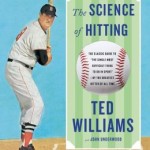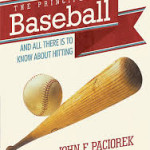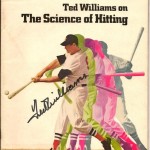Even at the lowest levels of cognition, hitting a baseball is an art form. And some artists are just better than others! But with a serious application of scientific involvement, couldn’t the artisanship be made to conform to a standard beyond what is customarily acceptable? Leonardo da Vinci expanded the scope of previous artistic standards with his own innovative application of scientific principles. Complementing his sensory sensitivity with the calculating precision of scientific understanding, he let principle and finesse govern the practical beauty of his structural and delicate successes. His work reached the confluent acme of scientific artistry!
What is it that prevents Baseball’s hitters from expanding the boundaries of batting excellence to a point at or beyond the .400 mark? It is both a lack of insight and perspective that prohibits a mechanism from becoming readily available to catapult any prospective bats-man beyond the self-imposed limits of ignorance and irresponsible conformity. Three hits in ten at-bats seems a reasonable respectability to anyone willing to ignore a pathetic 30 to 35 percentile efficiency-rating as being the high standard bearer for baseball’s batting elite. Though it is true that hitting a baseball is the single-most difficult task in all of Sports (as ascertained by Ted Williams), is it reasonable to become complacent with a productivity rating whose low level has no comparable equivalence in any other area of business or athletic acumen?
A hope-filled pragmatist within the realm of Baseball’s professional bats-men might investigate all means (scientific and otherwise) by which that abhorrent statistical anomaly can be improved upon or removed, or at least be diminished from the tablet of baseball consciousness. What would such an investigative assignment entail? It would probably include reconnoitering all available resource reference material that would be pertinent in order to attack such a bewildering set of circumstances. 
All the greatest minds in history would probably have to be consulted for their expert opinions as to the mesmerizing and enigmatic circumstances involved, from Socrates, Plato  and Aristotle to Newton, Einstein, Stengel, Berra, Paciorek, as well as St. Paul, Augustine, and Mary Baker Eddy.
and Aristotle to Newton, Einstein, Stengel, Berra, Paciorek, as well as St. Paul, Augustine, and Mary Baker Eddy.
Borrowing from the Platonic dialogues, let us begin with a Socratic Dialectic inquiry so as to advance beyond an initial stage of ignorance. Why is it not possible for a batter to get a base hit every time he comes to bat? The immediate intelligent and practical answer would probably be that the 9 defensive players would somehow find a way to prevent that from happening—it has been a tradition in almost 7 of 10 at-bats. But Socrates might further the dialogue by asking “What would prevent the fielders from catching the ball when he hits it (if he didn’t strikeout)?”
A perceptive “interlocutor” might venture an array of educated guesses. “If he hit the ball over the fence, the fielders couldn’t catch it! And if he demonstrated an exact and precise principle of batting technique, the mechanics of which would considerably lessened the margins of erroneous calculation, then it might be theoretically possible to maximize his effectiveness to a more certain degree.”
Tirelessly in pursuance of an ultimate solution, Socrates might again inquire, “Is it conceivable for a batter with highly acute physical sense perception and strength, as well as pronounced scientific understanding and demonstrable application of sound mechanical principle to effect a flawless swing that would propel the baseball over the fence every time a ball was pitched for a strike?” The mindful student might respond, after thoughtful consideration, that “it is conceivable, to thought, that such a prospect would be possible, but the human practicality of such a degree of success would seem highly improbable.”
Albert Einstein would probably agree with the perceptive student, since his  Relativity Theories precipitated the onset of Quantum Mechanics whose main postulate states that “at the fundamental levels of matter causation is a matter of statistical probabilities, not certainties.” But Newton’s advanced mathematical appliance of Calculus certainly made it evident that previously incomprehensible circumstances were now afforded a venue from which to reduce those margins for error that had previously exacerbated most querulous situations.
Relativity Theories precipitated the onset of Quantum Mechanics whose main postulate states that “at the fundamental levels of matter causation is a matter of statistical probabilities, not certainties.” But Newton’s advanced mathematical appliance of Calculus certainly made it evident that previously incomprehensible circumstances were now afforded a venue from which to reduce those margins for error that had previously exacerbated most querulous situations.
Since Socrates’ method of teaching always left room for additional inquiry, although the responsive student advanced to a higher plane of understanding, the solution was assigned to greater depths of investigation and personal practice. But Aristotle offered some advice to those searching for excellence. From his “Nicomachean Ethics,” I paraphrase what he said, “in order to begin a study of anything that would lead to the highest understanding and demonstration of its universal verity, one must behold an example of a closest facsimile to the ideal estate, study its admirable characteristics, and extrapolate from its obvious functional proficiency a common entity by which a generic standard could be discerned, duplicated, and possibly expanded upon.”
The Bible may have put it even more succinctly, where in Psalm (37:37) it is stated, “Mark the perfect man and behold the upright; for the end of that man is peace.” Excellence in any field of human endeavor is achievable to anyone willing to devote a “heart and soul” effort toward mastering the definable concomitants to successful enterprise.
Astute analytical research on the topic of “The most productive means for becoming a most proficient Bats-man,” would have to begin with a visionary outline of what might be considered the various degrees of observable competence and perhaps the underlying characteristics (if any) of the ultimate form of “excellence.”  Then, perhaps an elaboration of those varying degrees (with examples and illustrations) could describe the characteristics of each, and establish a platform for any prospective high achiever to undertake advancement toward that Ultimate goal.
Then, perhaps an elaboration of those varying degrees (with examples and illustrations) could describe the characteristics of each, and establish a platform for any prospective high achiever to undertake advancement toward that Ultimate goal.
End Part II
Coming Soon: Part III